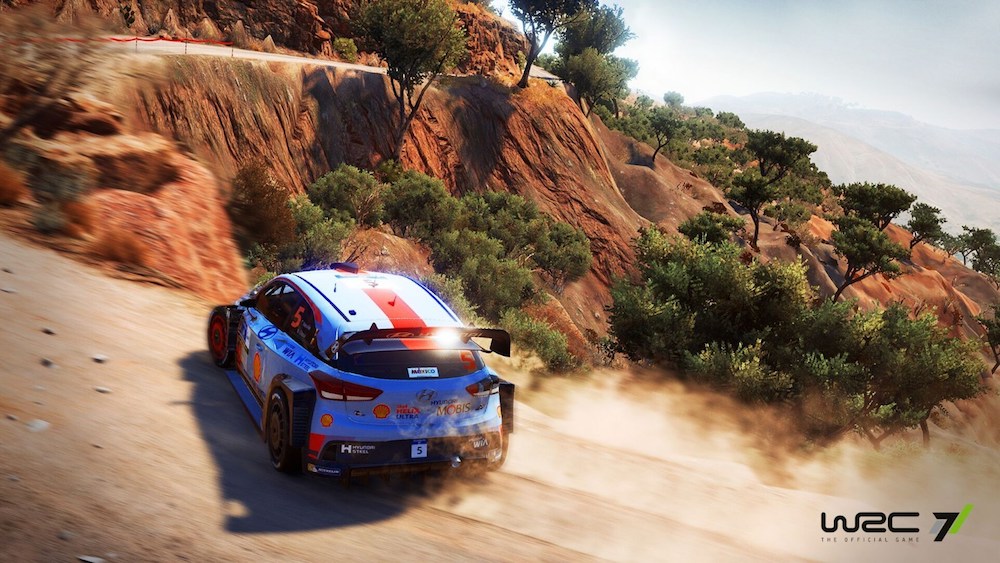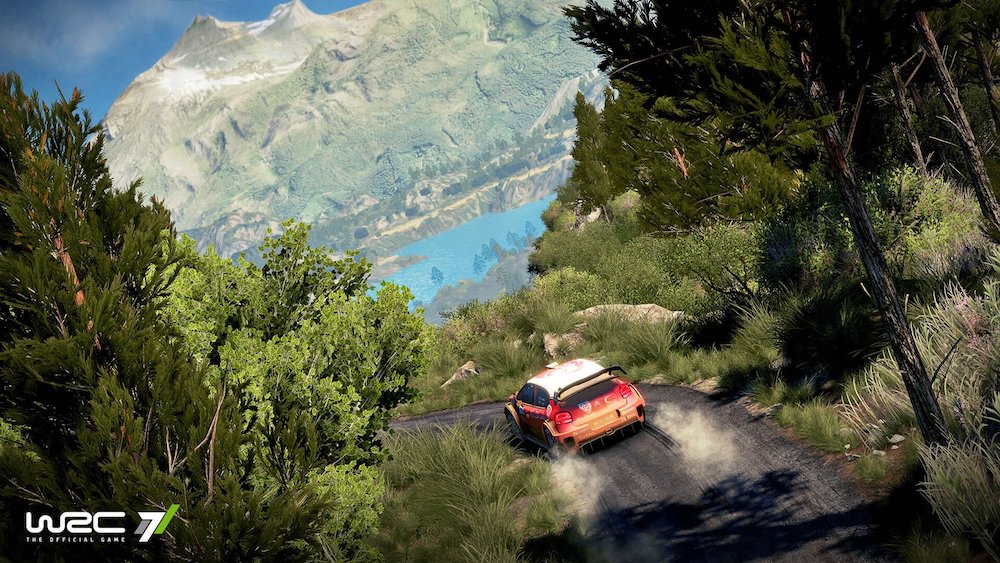
WRC 7 is the third officially licensed WRC rally game developed by Kylotonn and published by Bigben Interactive. So far this collaboration has panned out well for the series with Kylotonn’s previous effort, WRC 6, turning out to be a solid rally game and an excellent foundation to continue to build upon. In saying that, though, with all annual releases there still comes a concern that the developers could just be phoning it in with simple skin updates instead of adding anything substantial to the game. To date, however, Kylotonn have improved upon their previous efforts with each new instalment, and I’m glad to say this is once again the case with WRC 7, which is another step forward for the series.
WRC 7 starts with a familiar introduction. As soon as you launch the game, you’re thrown straight into a test stage to gauge your level of competence. Unfortunately, jumping in cold like this tends to be a disaster the first time around, but you can restart the stage as often as you like until you get comfortable. I’m not really sold on the merit of this approach, but it does get you driving as soon as possible and showcases the game up front without going through the menus first.
The menu system itself is simple enough to follow with very smooth and fast transitions, so you aren’t left waiting. You can quickly access any part of the game from the main menu and settings aren’t nested too many levels deep. The game is split into three play types: solo, multiplayer and online challenges.
The main attraction for solo play is the championship campaigns. You start by signing up for a Junior WRC team, and by picking a contract to sign from a limited choice. You are presented with the option of joining a team that values looking after the car or one that prefers you go flat out for the win. You get bonus points for completing specific objectives during rallies that align with the team’s focus, which may include goals like finishing a stage without damaging the car or making the podium. Once you complete the Junior WRC season, you can move onto the WRC2 category, which features a few more rallies. After that, you get a drive in the top-level World Rally Championship with the full calendar of rallies.

The full calendar of rallies is where WRC 7 excels against the DirT series. One of the issues I had with DirT 4 is that it felt like a random selection of rallies that you just had to tick off until you completed 100%. Some of the championships were just two or three rallies long, and the rallies only featured a couple of stages each. There was never any sense that you were in a real fight for a title. WRC 7 is all about the campaign. You really get the sense that you are in a season-long fight for a prestigious accolade. It’s all about maximising your performance on each rally, even if you don’t win so that you can triumph at the end of a long season.
That feeling that you are just playing a game of random events in DirT 4 extended to the rally stages, too. As mentioned in my review of Dirt 4, the stages had an element of “procedural generation,” but the reality is that you’d see the same pre-made sections repeated a number of times throughout the stages. The stages in WRC 7, by contrast, are carefully hand-crafted representations of their real-world counterparts. The attention to detail in the stages is stunning. You get a feeling that you are driving through the real locations that you can see on TV. In some cases, these are exact replicas of real-world stages such as the Harju stage from Rally Finland. Although, the developers have judiciously chosen to shorten the longer stages to make them more palatable for a gaming audience. For example, the mighty El Chocolate stage in Rally Guanajuato Mexico is 54km long. That takes crews the better part of 40 minutes to complete. The El Chocolate stage in WRC 7 is just 18km, but, as it stands, it still feels like a marathon challenge, and you get a real sense of relief and accomplishment when you get to the end.
It isn’t just the layout of the stages that is true to life, though, but the attention to detail in the design, textures and lighting of the tracks and trackside objects. The stages look absolutely real, even down to bugs floating around in forest stages. There’s actual weight and thickness to the atmosphere in WRC 7 which comes out especially when it’s raining, misty or the sun is low in the sky. The lighting and shadows in WRC 7 are again a real strong point. In fact, stages can look and feel very different to drive depending on whether you’re driving them at high noon, dusk or night.

While the focus of WRC 7 is on the championship campaigns, there’s plenty more rally action to participate in. As with previous editions, there are online challenges you can compete in, such as the daily and weekly challenges where you’re given a stage to tackle to set your fastest time. You can then compare your time on the worldwide leaderboard and quickly filter the results so you can compare yourself directly to your friends. You can also create your own custom rallies from any of the locations and stages in the game. As far as multiplayer goes, there’s an abundance of options, but at the time of reviewing, I couldn’t find anyone to play with via the online matchmaking service which was disappointing. You can at least create your own lobby and invite friends, and if that’s not suitable, you also have two local multiplayer options: hot seat and split-screen. It’s great to see so many options to play with your friends because it adds to the replay value of the game once you’re done with the championships. There’s also going to be an official eSports championship in WRC 7 for the 2018 season. The big news is that participation in the eSports championship is to be free, so if you’re curious how an eSports competition works, this is the perfect opportunity to give it a go.
Since WRC 7 focuses on the World Rally Championship and its supporting categories, the choice of cars available is limited to those in the FIA sanctioned championships of Junior WRC, WRC2 and WRC. The one-make Junior WRC brings you the Ford Fiesta R2. From WRC2 you get a Ford Fiesta R5, Citroen DS3 R5, Peugeot 208 T16 R5 and the Skoda Fabia R5. From the top-level WRC category, you get to choose from an M-Sport Ford Fiesta RS WRC, a Hyundai i20 Coupe WRC, a Toyota Yaris WRC, Citroen C3 WRC and a BMW MINI JCW WRC (that’s a lot of capital letters). There’re also some bonus cars included in the game. These are mainly all the manufacturer team cars from the 2016 season, including the now-departed but highly successful Volkswagen Polo R WRC. It’s also worth noting there’s one DLC car available: a Porsche 911 GT3 RS R-GT (another mouthful). This car is a lot of fun to throw around, and I’m glad it’s available, but I’d love to see more cars from the rich history of the World Rally Championship – just not at $5 USD each. As great as the new cars are, the inclusion of the heroes of the past would really add to the draw of this series. Since this is an officially licensed FIA WRC product, it seems like a slam dunk waiting to happen.
Sound is also important to the immersion of any car game, and one of the most important aspects is the sound of the engines. The engine sounds in WRC 7 are excellent and a good improvement over previous titles in my opinion. Naturally, the engines sounds are best appreciated from the outside, which is a shame because I like to drive with the cockpit camera where the sounds are more muted. All other sounds in WRC 7 are spot on, too. The whining gearboxes, the flutter of the turbo when you lift off the throttle, the burble and crack of exhausts on the overrun, the clunk of the transmission and the squealing brakes. All the ancillary vehicle sounds are spot on and really add to the immersion in the game.

Car handling and physics are, of course, fundamental aspects of a rally game. Here I have to give credit to Kylotonn because even with a controller the cars feel like they have weight and momentum. You can feel that the cars have inertia as you brake hard for corners and swing them into a slide. There’s a substantial feeling to the way the cars land after a decent jump. Kylotonn have tuned the controller input perfectly for their game, so I didn’t feel the need to adjust the controller settings much, which is just as well because you don’t get nearly as many options as you do in a Codemasters title.
If you like to have a bit more control over your car, I would recommend reducing the accelerator sensitivity. I tested the game with a steering wheel, of course, and found the experience initially frustrating as I did with previous WRC titles. I had to play around a lot with the force feedback settings to get a good feel. Just as with previous titles, the main force feedback setting is set at 100% and this makes it feel like steering a car with no power steering. Once I got the right blend of settings, the driving was a lot of fun, and that sense of weight and momentum was still there. You still get a lot of feeling through the wheel because there are separate force feedback sliders for forces coming from the tyres and suspension. I would say the detail in the feedback isn’t as high as with DirT Rally, which is the benchmark in my mind, or even DirT 4, but it’s still very good and doesn’t detract much from the enjoyment of the experience. If you want a rally game that plays well with a controller, WRC 7 is excellent and far more accessible than DirT Rally which really needs a steering wheel.
Despite the praise I have to offer, there are still a few gripes I need to bring up. The attention to detail that went into the stages doesn’t extend to the same level with the cars. The models are decent enough, if perhaps a little basic in parts, such as the interior, but the sponsor decal textures are somewhat low in resolution. This is really apparent when you see the car close up from certain camera angles in replays. Although the lighting in the game is absolutely brilliant, in replays you notice that the light from the cars does not seem to emanate from the cars’ headlights. It’s just sort of there. It’s also disappointing that you cannot choose all of the camera angles in replays. When you select the “TV coverage” style replay camera, the view switches automatically to some really nice camera angles, but you can’t manually choose those them. The helicopter camera angle also behaves a bit weirdly at times, with jarring panning and tracking taking away from the immersion. I’d love to see an improvement in this area. Kylotonn have also elected to dispense with functionality to save and load setups. It’ll remember your preferences for gravel and tarmac separately, but these do not seem to be saved per-rally. I get that the developers may have elected to simplify things here, but it seems like a bit of an omission, especially when previous titles allowed you to load and save setups.

WRC 7 is another solid effort from Kylotonn with improvements in all the critical areas of physics, graphics and sounds. The stages are once again beautifully designed and rendered with stunning visuals. Engine and atmospheric sounds are spot on and really add to the immersion, and the handling and physics are excellent. The cars feel like they have real weight. It’s also worth noting this is a great rally simulation to play with a controller or a wheel, and there’s heaps of replay options with multiplayer and the upcoming eSports championship in 2018. WRC 7 is heavily focused on the current FIA World Rally Championship, so if you’re looking for a wide vehicle choice or fantasy tracks you need to look elsewhere. If you’re a fan of rallying, however, this is a simulation that should be in your collection.











